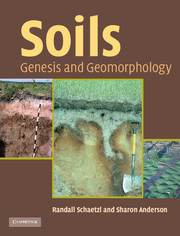Book contents
- Frontmatter
- Contents
- Preface
- Acknowledgements
- Part I The building blocks of the soil
- 1 Introduction
- 2 Basic concepts: soil morphology
- 3 Basic concepts: soil horizonation … the alphabet of soils
- 4 Basic concepts: soil mineralogy
- 5 Basic concepts: soil physics
- 6 Basic concepts: soil organisms
- 7 Soil classification, mapping and maps
- Part II Soil genesis: from parent material to soil
- Part III Soil geomorphology
- References
- Glossary
- Index
3 - Basic concepts: soil horizonation … the alphabet of soils
from Part I - The building blocks of the soil
- Frontmatter
- Contents
- Preface
- Acknowledgements
- Part I The building blocks of the soil
- 1 Introduction
- 2 Basic concepts: soil morphology
- 3 Basic concepts: soil horizonation … the alphabet of soils
- 4 Basic concepts: soil mineralogy
- 5 Basic concepts: soil physics
- 6 Basic concepts: soil organisms
- 7 Soil classification, mapping and maps
- Part II Soil genesis: from parent material to soil
- Part III Soil geomorphology
- References
- Glossary
- Index
Summary
Regolith, residuum and the weathering profile
Soil is different than sediment. Soil develops from sediment, in sediment. Knowing how to distinguish the two is critical to the application of soils knowledge (Mandel and Bettis 2001). Soils develop within weathered, unconsolidated (parent) materials at the Earth's surface, under the influence of biota and climate. Soil cannot form within solid rock, but can form within the weathered by-products of that rock.
Loose, unconsolidated material at the earth's surface is regolith. It can have one of two origins: (1) formed in place as bedrock weathers, or (2) transported to a site by gravity, water, wind, ice or another vector (Fig. 3.1) (see Chapter 8). The first material is referred to as residual regolith, or simply, residuum. It is most common on stable uplands in unglaciated parts of the world; in glaciated regions it is either deeply buried or long-since eroded. Transported regolith can take many forms, such as alluvium, glacial drift or eolian sand.
Regolith is exposed to the vagaries of climate and is acted upon by biota. In this process, it is eroded, transported, deposited, and most importantly (to soil formation) weathered, which encourages various components of it to be reorganized and translocated internally. Residual regolith is weathered out of rock, and therefore all parts of it can be considered weathered, but some types of transported regolith are little weathered, especially if buried deeply. Thus, immediately below the soil profile one might observe zones in transported regolith that are only slightly altered, primarily by leaching and/or oxidation.
- Type
- Chapter
- Information
- SoilsGenesis and Geomorphology, pp. 32 - 53Publisher: Cambridge University PressPrint publication year: 2005



